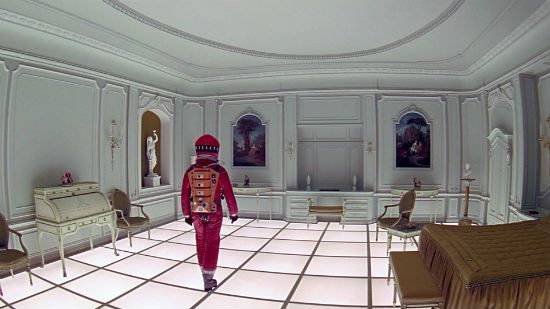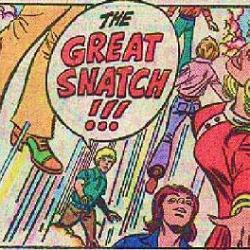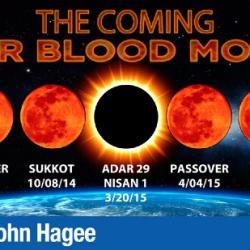Originally posted May 22, 2009.
You can read this entire series, for free, via the convenient Left Behind Index. The ebook collection The Anti-Christ Handbook: Volume 1, is available on Amazon for just $2.99. Remember you were refugees and slaves in Egypt, you ungrateful bastards. Volume 2 of The Anti-Christ Handbook, completing all the posts on the first Left Behind book, is also now available. Volume 3 is coming soon(ish).
Tribulation Force, pg. 45
It’s been a busy couple of weeks at New Hope Village Church:
Saturday morning Buck drove to New Hope Village Church, hoping to catch Bruce Barnes in his office. The secretary told him Bruce was finishing up his sermon preparation, but that she also knew he would want to see Buck. “You’re part of Bruce’s inner circle, aren’t you?” she said.
So the church now has a secretary. That’s new.
NHVC seems to have reconstituted itself, in just two weeks, into just the sort of typical evangelical church that the book’s intended readers would recognize. Everything about the scene is reassuringly familiar — like walking into a McDonald’s or a Starbucks.
In the context of our story, though, it’s more like walking into a Starbucks on the moon.
None of this should be here — not the secretary, not the reassuring sense of established routine, not the large congregation behaving exactly like any typical pre-Event, pre-cataclysm large congregation. The very mundane normalcy of it all is itself surreal — like that eerily out-of-place room at the end of 2001: A Space Odyssey.

This secretary and this typical Saturday at an ordinary church don’t belong in this story. Bruce has conducted a handful of meetings for skeptics and seekers, and he’s had a couple of Sundays to drum up a new congregation, but that doesn’t explain how NHVC would be able to completely replace its previous membership in two short weeks. Nor could anything explain how this replacement congregation would know how to behave exactly like the community they’re replacing.
If any other authors had been writing this story, then the Event would likely have produced a wave of newcomers to the church. The Event was an incomprehensible mass tragedy — the disappearance of everyone’s children, of every child that everyone everywhere knows. That’s unprecedented, of course, but from what we know of less comprehensive tragedies, we can imagine what would happen.
When tragedy strikes a community, a steeple becomes a giant sign reading “Chaplain’s Office” and people just kind of show up at churches. Whether or not they belong to any given congregation, the response to communal tragedy is to congregate. This happens after mining disasters, earthquakes, tornados, floods, school bus accidents and shooting sprees. People gather at churches not to seek or to share answers, but just because the doors will be open, and there’s a big enough room and a ready supply of candles. (School gymnasiums can play a similar role for similar reasons, but they never have enough candles and, for most of us, memories of gym class don’t convey the same reassuring connotations as going to a “sanctuary.”)
This impulse to gather is useful and even necessary as the community struggles to sort things out — to figure out what just happened and who’s affected and what do we need to do next. So the mayor and the police and fire chiefs and the head of the local Red Cross all make their way to the churches too. They’ll gather at the edge of the candlelight vigil and assess the situation, enlisting and accepting the support of volunteers, accounting for the absent, and keeping the gathered community as well-informed as possible about what just happened or is happening. Downstairs, in the big practical space of the church basement, folding tables will be set up and volunteers will start organizing the emergency shelter or the first-aid station or the blood drive or the endless pot-luck dinner for the sand-bag teams. Someone will put on the big coffee urn that all church basements have because it’s going to be a long night and no one’s going anywhere until we sort out the full extent of the situation. The vigil and the volunteering can last for days, with sleepless people urging each other to go home and try to get a few hours sleep — advice that no one seems willing or able to take.
That, more or less, is what happens all the time. But none of that happened here, in these books.
In the aftermath of the Event, NHVC was, for days, an empty husk, haunted only by the ghosts of Bruce and Loretta. There were no candlelight vigils and no ad hoc community gatherings. Mayors and police chiefs and Red Cross officials did not assemble, assess or respond and the need for some kind of communal Chaplain’s Office seems to have been met via a CNN broadcast of a press conference by the president of Romania. Strangest of all, grieving parents all seem to have responded just the way Rayford Steele did. After a brief evening of sorrow, they went back to work, shopped for groceries and picked up their childless but otherwise unperturbed daily routines as though nothing much had happened.
We’ve noted, repeatedly, the sheer inhuman impossibility of this non-reaction to the Event. Here we add another impossibility to the list: A thriving, routine congregation of brand new, post-Event converts that behaves exactly like any thriving, routine congregation of life-long, pre-Event RTCs.
This is more insanity. None of the members of this congregation belonged to this church three weeks ago or even thought about joining. They know next to nothing about the content or substance of what it is that NHVC-type Christians are supposed to believe. With no Peter, Paul or Priscilla around, they’d be lucky to find even an Apollos to guide them. (Apollos, the Book of Acts tells us, was a dynamic preacher in the early first-century church, but a dynamic preacher who didn’t really understand what it was he was supposed to be preaching about.)
More to the point, they wouldn’t have the slightest sense of the mores or customs or routines of the congregation they’re replacing. Sunday morning worship they could probably stumble through, but the rest of it was a structure and schedule designed for a community and a world that no longer exists. They would be far too busy trying to rebuild their own community in their own, new post-Event world to have the time or inclination to try to recreate this weird facsimile of the local church world that was.
This is what post-apocalypse stories are for — what they’re supposed to do. We see a new community coming together and applying its courage and ingenuity to build a new world and a new society in its new context, after the shipwreck or the flood or the invasion or the outbreak. By exploring what society would look like in that new context, such stories — Swiss Family Robinson, Jericho, Jeremiah, Waterworld, Night of the Living Dead, Gilligan’s Island— provide a new perspective for understanding the meaning of our society in our context. Such stories take apart the world so that we can look inside to see how it works.
Tim LaHaye and Jerry Jenkins have spent decades within the world of local evangelical churches. They ought to know that world — how it works and why it works, or doesn’t work, the way it does. They ought to know that world with enough intimacy and insight to be able to show us here how that world would be changed if we replaced everyone in it with new, tabula-rasa believers coping with a shared and devastating tragedy. The potential is for something like a retelling or reimagining of the Book of Acts — or maybe like the Jerusalem church of CE 71 transplanted to 21st-century Illinois. Watching this community of neophytes attempt — with false starts and halting steps — to reinvent the wheel would give us a chance to remember or to relearn much that we might have forgotten or overlooked about wheels and how they roll.
But our authors, as we’ve seen time and again, aren’t really interested in this world or how it works. They may have spent many, many years in local congregations, but they haven’t been paying attention. We knew they didn’t care enough to pay attention to non-RTCs, but here, with the impossibly unchanged pre-Event routine of the new New Hope Village Church, we see that they don’t really care much about their own RTC community either.
The church secretary seems to have picked up on this disregard. There’s a hint of frustration in her reference to “Bruce’s inner circle” — a trace of the exasperation of someone struggling with a monumental task who is forced to abide the irrelevant distraction of her boss’s time-wasting preoccupations. It’s the same sort of tone one hears in corporate offices when the underpaid and overworked administrative assistant is told to set aside some vital task in order to draft yet another memo in the CEO’s name clarifying the distinction between a mission statement and a vision statement.
What we’re seeing here, in other words, is a glimpse of meta-secretary, straining against the absurdity of her inexplicable presence in this impossible scene.
Who is this woman and how did she come to be working here? What was she doing three weeks ago and how did it come to pass that she was able to choose to stop doing that and start doing this? Does she even get paid to work here at the church, and if so, how does that work? The rapturing of Senior Executive Uber-Pastor Billings and the rest of the staff other than Bruce would have freed up much of NHVC’s personnel budget, but that budget was based on a presumed level of weekly giving from a congregation that no longer exists. It seems unlikely that the new congregation would even know how to conduct an offering, let alone be in a position to rely on one. And if the secretary is getting paid, who is supposed to sign her paycheck? The church treasurer and the rest of its board are all gone — every officer of the 501(c)(3) nonprofit that owns the church’s bank accounts and its property.
So when this church secretary greets Buck outside of Bruce’s office, we catch a glimpse not just of the meta-secretary, but of the whole meta-congregation. While Bruce is locked in the study, poring over the marginalia in Billings’ old copy of 88 Reasons Why the Rapture Will Be in 1988,* these folks would be working hard to rewrite the second chapter of Acts, adding to their number daily those who were being saved.**
I imagine Loretta working with some new-member lawyers to reconstitute the church board, thus regaining access to NHVC’s accounts so they can keep the lights on and so that the new congregation is no longer trespassing on the old congregation’s property. Loretta’s next step would have been to hire the secretary to keep Bruce out of the way, and then to hire enough on-call staff to keep the overwhelmed grief-counseling ministry operating 24/7.
Like the church secretary, Loretta is there at the church even on Saturdays because there’s so much work to do. She’s got a committee of volunteers finishing up the house-by-house canvassing of the neighborhood — sorting out who’s missing, who’s dead and who’s curled up in the fetal position, silently mouthing the names of their missing children. And she’s got another volunteer committee in charge of duplicating and distributing Pastor Billings’ video, which is also being shown, round the clock, on a giant screen set up in the sanctuary. Loretta’s also trying to figure out the ethics of the second mortgage that the new treasurer wants to take out on the property — does a 30-year mortgage count as stealing when the bank doesn’t know the world is about to end, or is that an acceptable case of “plundering the Egyptians”? And then she’s got that meeting this afternoon with those kids from the new church over in Wheaton.
With all of that on her plate, it was a relief that Bruce didn’t ask her to be part of his inner circle. And it’s perfectly understandable that she ducked around the corner to hide when she saw Buck arrive.
With the announcement that Buck was waiting, Bruce immediately swung open the door and embraced him. That was something new for Buck, too, all this hugging, especially among men. Bruce looked haggard.
In Jenkins’ defense, when he typed this passage in 1996 he could have had no idea that the word “haggard” would one day induce giggles in the context of a discussion of discomfort with male expressions of affection.
… all this hugging, especially among men. Bruce looked haggard. “Another long night?” Buck asked.
OK, then.
– – – – – – – – – – – –
* True story: In 1994, while I was working part-time in a bookstore, a customer asked me to special order a copy of that book. I looked it up and then told her that we couldn’t get it for her because it was out of print.
“When did it go out of print?”
“My guess would be 1989.”
“That’s a shame. It’s a great book.”
“…”
** Actually, I would guess that for many of these new members, joining this congregation had little to do with being saved, or with personal faith per se. Many of these would be people who witnessed the Event two weeks ago and knew enough, from a thousand pop-culture references and allusions, to recognize a premillennial dispensationalist Rapture when they saw one.
Imagine some guy sitting at home watching the local news and laughing along with the reporter at the costumed geeks attending a local Star Trek convention. This guy, The Skeptic, has never seen a single episode of the show — he couldn’t tell Kirk from Picard if you paid him to guess. He thinks the whole thing is ridiculous.
But then, as he watches this live news report, a Klingon warship decloaks over the convention center and starts blowing up cars in the parking lot. As the news reporter stands there, dumbfounded and speechless, The Skeptic hears what even he recognizes as the beam-me-up-Scotty sound effect and suddenly all of the costumed geeks and conventioneers twinkle and vanish. Just before the cameraman faints and the signal is lost, The Skeptic sees the briefest glimpse of the starship Enterprise swooping in to engage the Klingon vessel.
It doesn’t matter at this point that he’s never seen the show — the iconic spaceship is instantly recognizable even to The Skeptic. Instantly, The Skeptic realizes that everything he thought he knew was wrong — that he is living in a Star Trek world and that everyone who might have been able to explain to him what that means is now gone.
Two weeks later, the former Skeptic finds himself at a Star Trek convention — a convention he helped to organize along with hundreds of others, all of whom, like him, never watched the show and know next to nothing about it. And there is no one there to explain it to them. It is a Star Trek convention without Trekkers — a Star Trek convention comprised entirely of people who haven’t seen Star Trek and don’t understand it.
That is what the congregation of the new New Hope Village Church would be like.
The authors seem to hold two contradictory views about this potential PMD-“genre-savvy” among those left behind. On the one hand, they portray the entire world as being cluelessly mystified when confronted with what should be instantly recognizable as a PMD Rapture. On the other hand, the whole point of these books is to warn every skeptic who rejects the supreme truths of PMD prophecy mania that they’ll see, someday very soon, that the PMDs were right all along. This vindication and comeuppance relies on the idea that the Rapture will be universally and undeniably recognized as precisely what it is by all those left behind.












